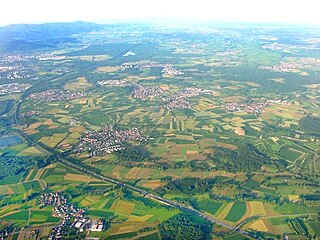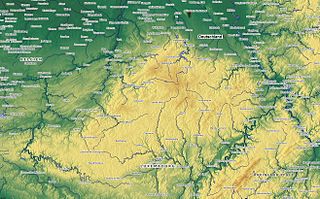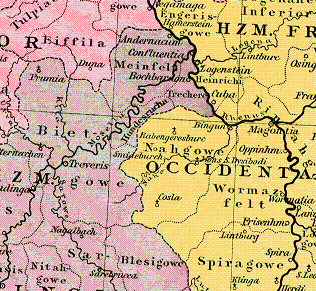 W
WBreisgau is an area in southwest Germany between the Rhine River and the foothills of the Black Forest. Part of the state of Baden-Württemberg, it centers on the city of Freiburg im Breisgau. The district Breisgau-Hochschwarzwald, which partly consists of the Breisgau, is named after the Black Forest area. Parts of the Breisgau are also situated in the political districts of Freiburg im Breisgau and Emmendingen.
 W
WThe Condroz is a natural region in the Wallonian (French-speaking) part of Belgium, located to the north-west of the Ardennes. Its unofficial capital is Ciney. The region preserves the name of the Condrusi, a Germanic tribe which inhabited the area in the Roman era.
 W
WThe County of Barcelona was originally a frontier region under the rule of the Carolingian dynasty. In the 10th century, the Counts of Barcelona became progressively independent, hereditary rulers in constant warfare with the Islamic Caliphate of Córdoba and its successor states. The counts, through marriage, alliances and treaties, acquired the other Catalan counties and extended their influence along Occitania. In 1164, the County of Barcelona entered a personal union with the Kingdom of Aragon. Thenceforward, the history of the county is subsumed within that of the Crown of Aragon, but the city of Barcelona remained preeminent within it. Within the Crown, the County of Barcelona and the other Catalan counties developed a common polity known as the Principality of Catalonia.
 W
WThe Derlingau was an early medieval county (Gau) of the Duchy of Saxony.
 W
WThe Eifelgau was a Frankish gau in the region of the present day Limestone Eifel in Germany.
 W
WThe County of Hainaut, was a territorial lordship within the medieval Holy Roman Empire, straddling what is now the border of Belgium and France. Its most important towns included Mons, now in Belgium, and Valenciennes, now in France.
 W
WThe Harzgau was a medieval shire (Gau) in the northeastern foorhils of the Harz mountains, part of the Eastphalia region of Saxony.
The Hassegau was a medieval shire (Gau) in the Eastphalia region of the Duchy of Saxony. It was located in the duchy's southeastern corner; confined by the Saale river to the east and its Unstrut and Wipper tributaries to the south and north. Its most important town was Merseburg. In present-day borders, it is in the southeastern part of Saxony-Anhalt.
 W
WThe Nordthüringgau was a medieval county in the Eastphalian region of the German stem duchy of Saxony.
 W
WThe Ortenau, originally called Mortenau, is a historic region in the present-day German state of Baden-Württemberg. It is located on the right bank of the river Rhine, stretching from the Upper Rhine Plain to the foothill zone of the Black Forest. In the south, it borders on the Breisgau region, covering approximately the same area as the Ortenaukreis, a present-day administrative district with its centre at Offenburg.
 W
WRaetia Curiensis was an Early medieval province in Central Europe, named after the preceding Roman province of Raetia prima which retained its Romansh culture during the Migration Period, while the adjacent territories in the north were largely settled by Alemannic tribes. The administrative capital was Chur in the present Swiss canton of Grisons.
 W
WThe Rheingau consists of the district on the Northern side of the Rhine between the German towns of Wiesbaden and Lorch near Frankfurt, reaching from the Western Taunus to the Rhine. It is situated in the German state of Hesse and is part of the Rheingau-Taunus-Kreis administrative district. It is famous for Rheingau wines, especially the "Rheingauer Riesling," and its many taverns.
 W
WThe Schwabengau was an early medieval shire (Gau) in the Eastphalia region of the medieval Duchy of Saxony. Ruled by the House of Ascania, it became the nucleus of the later Principality of Anhalt, today part of the German state of Saxony-Anhalt.
 W
WSpeyergau was a medieval county in the East Frankish (German) stem duchy of Franconia. It was centred around the administrative centre of Speyer and roughly covered the former Roman administrative area of Civitas Nemetum, which is today the south-eastern portion of the Palatinate region between the Rhine river, the Palatinate Forest range, and some smaller parts of northern Alsace. The Speyergau, together with the neighbouring Wormsgau and Nahegau, was part of the major possessions held by the Salian dynasty of German kings and Holy Roman Emperors.
 W
WStormarn was a gau which, alongside Holstein and Dithmarschen, was one of the three Northern Albingian Saxon gaus.